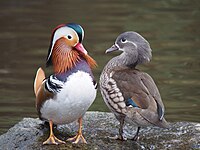
Photo from wikipedia
Abstract Genetic analyses of nuclear DNA (e.g., microsatellites) are a primary tool for investigating mating systems in reptiles, particularly marine turtles. Whereas studies over the past two decades have demonstrated… Click to show full abstract
Abstract Genetic analyses of nuclear DNA (e.g., microsatellites) are a primary tool for investigating mating systems in reptiles, particularly marine turtles. Whereas studies over the past two decades have demonstrated that polyandry (i.e., females mating with multiple males) is common in marine turtles, polygyny (i.e., males mating with multiple females) has rarely been reported. In this study we investigated the mating structure of Critically Endangered hawksbill turtles (Eretmochelys imbricata) at Bahia de Jiquilisco in El Salvador, one of the largest rookeries in the eastern Pacific Ocean. We collected genetic samples from 34 nesting females and hatchlings from 41 clutches during the 2015 nesting season, including one nest from each of 27 females and two nests from seven additional females. Using six highly polymorphic microsatellite loci, we reconstructed the paternal genotypes for 22 known male turtles and discovered that seven (31.8%) sired nests from multiple females, which represents the highest polygyny level reported to date for marine turtles and suggests that this is a common mating structure for this population. We also detected multiple paternity in four (11.8%) clutches from the 34 females analyzed, confirming polyandrous mating strategies are also employed. The high level of polygyny we documented suggests there may be a limited number of sexually mature males at Bahia de Jiquilisco; a scenario supported by multiple lines of empirical evidence. Our findings highlight key management uncertainties, including whether polygynous mating strategies can compensate for potential ongoing feminization and the low number of adult males found for this and possibly other marine turtle populations.
Journal Title: Journal of Experimental Marine Biology and Ecology
Year Published: 2018
Link to full text (if available)
Share on Social Media: Sign Up to like & get
recommendations!